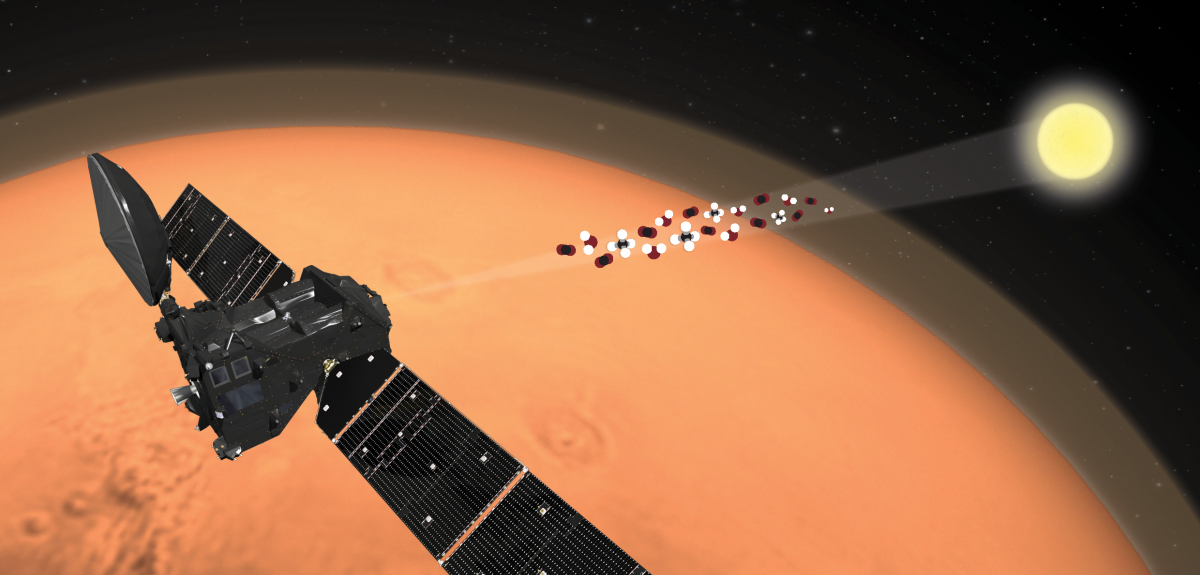
Credit: ESA/ATG medialab
British instruments reveal secrets of Martian sky
The first results from the ExoMars mission supported by the UK Space Agency reveal the effects of a massive, global dust storm on the Red Planet.
Over the last year the European Space Agency’s (ESA) Trace Gas Orbiter (TGO) spacecraft followed the onset of the storm and monitored how the increase in dust affected the water vapour in the atmosphere - important for understanding the history of water on Mars.
It did not observe the presence of methane gas, further adding to the mystery of why other missions like the NASA Curiosity rover reported higher localised concentrations, which could indicate life.
Juan Alday, from the University of Oxford’s Department of Atmospheric, Oceanic and Planetary Physics, who is contributing to the Trace Gas Orbiter, said: ‘The conclusions from these measurements are definitely very surprising, especially after the confirmation of the Curiosity Rover methane detection by Mars Express. The search for methane and other trace gases that might be indicative of its destruction will continue, helping us unravel the methane mystery on Mars.’
ExoMars is a two-part mission. The Trace Gas Orbiter will be joined by the UK-built Rosalind Franklin rover, which will roam the surface of the planet in 2021.
Sue Horne, Head of Space Exploration, UK Space Agency said: ‘ExoMars embodies the best of UK and European space science and I’m delighted that Britain is one of the biggest supporters.
‘This data release is the first of many on our mission to unearth the mysteries of the Red Planet. The results both answer, and raise new questions, paving the way for more exciting discoveries from the Rosalind Franklin rover which is due to launch next year.’
ESA’s Trace Gas Orbiter is studying Martian atmospheric trace gases and their sources in unprecedented detail. It will help scientists understand the source of the methane in Mars’ atmosphere and whether it is from a geological or biological source and provide a data connection to the Rosalind Franklin rover, currently under construction by Airbus in Stevenage, Hertfordshire.
Juan Alday contributes to The Atmospheric Chemistry Suite which is one of the four instruments on the Trace Gas Orbiter. His role within the ACS team is to carry out the analysis of the data using a radiative transfer code.
The Trace Gas Orbiter arrived in orbit 400 km above the Red Planet in April 2018, just a couple of months before the start of the massive dust storm that would eventually lead to the demise of NASA’s Opportunity rover after 15 years roving the Martian surface.
The ExoMars rover was named after UK scientist and co-discoverer of the structure of DNA Rosalind Franklin in February 2018, following a competition to which almost 36,000 people responded.
The UK Space Agency has invested €287 million to the overall ExoMars mission and €14 million to the instruments over 13 years, making it the second largest European contributor after Italy. A further £370,000 has been committed on the spacecraft’s instrument operations and over £2.5 million on data analysis.
 New study on Amazonia's fire crises urges action ahead of the next burning season
New study on Amazonia's fire crises urges action ahead of the next burning season
 New heart disease calculator could save lives by identifying high-risk patients missed by current tools
New heart disease calculator could save lives by identifying high-risk patients missed by current tools
 Modern Slavery and Human Rights Policy and Evidence Centre moves to Oxford University after receiving continuation funding
Modern Slavery and Human Rights Policy and Evidence Centre moves to Oxford University after receiving continuation funding
 Study shows that island bats are valuable allies for farmers
Study shows that island bats are valuable allies for farmers
 Study reveals how humanity could unite to address global challenges
Study reveals how humanity could unite to address global challenges